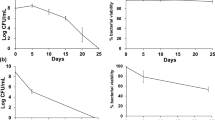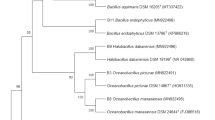Abstract
Bacteria under stress increase the proportion of dormant cells to ensure their survival. Cold and osmotic stress are similar, because in both the availability of water is reduced. Glycine betaine (GB) is one of the most common osmoprotectants in bacteria and possesses cryoprotectant properties. Our aim was to determine whether GB modifies the proportion of dormant Deinococcus sp. UDEC-P1 and Psychrobacter sp. UDEC-A5 cells exposed to osmotic stress. Both bacterial strains were incubated in the presence of up to 1 M NaCl with or without GB. Active and dormant cells were evaluated by both spectrophotometric and flow cytometry analysis. Without GB, Deinococcus sp. UDEC-P1 grew in the presence of 0.05 M NaCl, but with 5 mM GB grew at 0.1 M NaCl. Psychrobacter sp. UDEC-A5 grew in the presence of up to 0.25 M NaCl, but with 5 mM GB grew at 0.5 M NaCl. Under osmotic stress, the proportion of dormant cells of Deinococcus sp. UDEC-P1 and Psychrobacter sp. UDEC-A5 increased significantly (about eightfold and fivefold, respectively). The addition of GB (5 mM) exerted a different effect on the two strains, since it avoided the entrance into the dormancy of Psychrobacter sp. UDEC-A5 cells, but not of Deinococcus sp. UDEC-P1 cells. Our results suggest that the effect of GB on bacterial metabolism is strain dependent. For bacteria in which GB avoids dormancy, such as Psychrobacter sp. UDEC-A5, it could be a “double-edged sword” by reducing the “seed bank” available to recover the active population when favorable conditions return.





Similar content being viewed by others
References
Lennon JT, Jones SE (2011) Microbial seed banks: the ecological and evolutionary implications of dormancy. Nat Rev Microbiol 9:119–130
Wood JM (2011) Bacterial osmoregulation: a paradigm for the study of cellular homeostasis. Annu Rev Microbiol 65:215–238
Kandror O, DeLeon A, Goldberg AL (2002) Trehalose synthesis is induced upon exposure of Escherichia coli to cold and is essential for viability at low temperatures. Proc Natl Acad Sci 99:9727–9732
Kempf B, Bremer E (1998) Uptake and synthesis of compatible solutes as microbial stress responses to high-osmolality environments. Arch Microbiol 170:319–330
Wood JM (2015) Bacterial responses to osmotic challenges. J Gen Physiol 145:381–388
Cleland D, Krader P, McCree C, Tang J, Emerson D (2004) Glycine betaine as a cryoprotectant for prokaryotes. J Microbiol Meth 58:31–38
Chattopadhyay MK (2002) The cryoprotective effects of glycine betaine on bacteria. Trends Microbiol 10:311
Darcan C, Ozkanca R, Idil O, Flint KP (2009) Viable but non-culturable state (VBNC) of Escherichia coli related to EnvZ under the effect of pH, starvation and osmotic stress in sea water. Pol J Microbiol 58:307–317
Guerra M, González K, González C, Parra B, Martínez M (2015) Dormancy in Deinococcus sp. UDEC-P1 as a survival strategy to escape from deleterious effects of carbon starvation and temperature. Int Microbiol 18:189–194
Mocali S, Chiellini C, Fabiani A, Decuzzi S, Pascale D, Parrilli E, Tutino ML, Perrin E, Bosi E, Fondi M, Lo Giudice A, Fani R (2017) Ecology of cold environments: new insights of bacterial metabolic adaptation through an integrated genomic-phenomic approach. Sci Rep 7:839–852
Ponder MA, Gilmour SJ, Bergholz PW, Mindock CA, Hollingsworth R, Thomashow MF, Tiedje JM (2005) Characterization of potential stress responses in ancient Siberian permafrost psychroactive bacteria. FEMS Microbiol Ecol 53:103–115
Bakermans C, Ayala-del-Río HL, Ponder MA, Vishnivetskaya T, Gilichinsky D, Thomashow MF, Tiedje JM (2006) Psychrobacter cryohalolentis sp. nov. and Psychrobacter arcticus sp. nov., isolated from Siberian permafrost. Int J Syst Evol Microbiol 56:1285–1291
Fernandez-Bunster G, Gonzalez C, Barros J, Martinez M (2012) Quorum sensing circuit and reactive oxygen species resistance in Deinococcus sp. Curr Microbiol 65:719–725
Don RH, Cox PT, Wainwright BJ, Baker K, Mattick JS (1991) 'Touchdown' PCR to circumvent spurious priming during gene amplification. Nucleic Acids Res 19:4008
Weisburg WG, Barns SM, Pelletier DA, Lane DJ (1991) 16S ribosomal DNA amplification for phylogenetic study. J Bacteriol 173:697–703
Aranda C, Godoy F, Becerra J, Barra R, Martínez M (2003) Aerobic secondary utilization of a non-growth and inhibitory substrate 2, 4, 6-trichlorophenol by Sphingopyxis chilensis S37 and Sphingopyxis-like strain S32. Biodegradation 14:265–274
Beumer RR, TeGiffel MC, Cox LJ, Rombouts FM, Abee T (1994) Effect of exogenous proline, betaine, and carnitine on growth of Listeria monocytogenes in a minimal medium. Appl Environ Microbiol 60:1359–1363
Herbert RA (1990) Methods for enumerating microorganisms and determining biomass in natural environments. In: Grigorova R, Norris W (eds) Methods in microbiology. Techniques in microbial ecology. Elsevier, London, pp 1–39
Baty F, Delignette-Muller ML (2004) Estimating the bacterial lag time: which model, which precision? Int J Food Microbiol 91:261–277
Johnsen AR, Bendixen K, Karlson U (2002) Detection of microbial growth on polycyclic aromatic hydrocarbons in microtiter plates by using the respiration indicator WST-1. Appl Environ Microbiol 68:2683–2689
Cox MM, Battista JR (2005) Deinococcus radiodurans-the consummate survivor. Nat Rev Microbiol 3:882–8892
Amato P, Christner BC (2009) Energy metabolism response to low temperature and frozen conditions in Psychrobacter cryohalolentis. Appl Environ Microbiol 75:711–718
Im S, Joe M, Kim D, Park DH, Lim S (2013) Transcriptome analysis of salt-stressed Deinococcus radiodurans and characterization of salt-sensitive mutants. Res Microbiol 164:923–932
Oren A, Bardavid RE, Kandel N, Aizenshtat Z, Jehlička J (2013) Glycine-betaine is the main organic osmotic solute in a stratified microbial community in a hypersaline evaporitic gypsum crust. Extremophiles 17:445–451
Scholz A, Stahl J, Berardinis V, Müller V, Averhoff B (2016) Osmotic stress response in Acinetobacter baylyi: identification of a glycine-betaine biosynthesis pathway and regulation of osmoadaptive choline uptake and glycine betaine synthesis through a choline-responsive BetI repressor. Env Microbiol Rep 8:316–322
Cayley S, Lewis BA, Record MT (1992) Origins of the osmoprotective properties of betaine and proline in Escherichia coli K-12. J Bacteriol 174:1586–1595
Hoffmann T, Wensing A, Brosius M, Steil L, Völker U, Bremer E (2013) Osmotic control of opuA expression in Bacillus subtilis and its modulation in response to intracellular glycine betaine and proline pools. J Bacteriol 195:510–522
Wargo MJ (2013) Homeostasis and catabolism of choline and glycine betaine: lessons from Pseudomonas aeruginosa. Appl Environ Microbiol 79:2112–2120
Chou FI, Tan ST (1991) Salt-mediated multicell formation in Deinococcus radiodurans. J Bacteriol 173:3184–3190
Csonka LN (1989) Physiological and genetic responses of bacteria to osmotic stress. Microbiol Rev 53:121–147
Acknowledgements
This study was supported by grant Enlace VRID 214.036.041-1.0. The authors would like to thank Miss Ruth Contreras for her technical support and to the “Centro de Microscopía Avanzada” (CMA BioBio, University of Concepcion, Chile) for the cytometry analyses.
Author information
Authors and Affiliations
Corresponding author
Ethics declarations
Conflict of interest
The authors declare that they have no conflict of interest.
Additional information
Publisher's Note
Springer Nature remains neutral with regard to jurisdictional claims in published maps and institutional affiliations.
Rights and permissions
About this article
Cite this article
Gonzalez, K., Parra, B., Smith, C.T. et al. Glycine Betaine Effect on Dormancy in Deinococcus sp. UDEC-P1 and Psychrobacter sp. UDEC-A5 Exposed to Hyperosmotic Stress. Curr Microbiol 76, 1435–1442 (2019). https://doi.org/10.1007/s00284-019-01763-z
Received:
Accepted:
Published:
Issue Date:
DOI: https://doi.org/10.1007/s00284-019-01763-z




